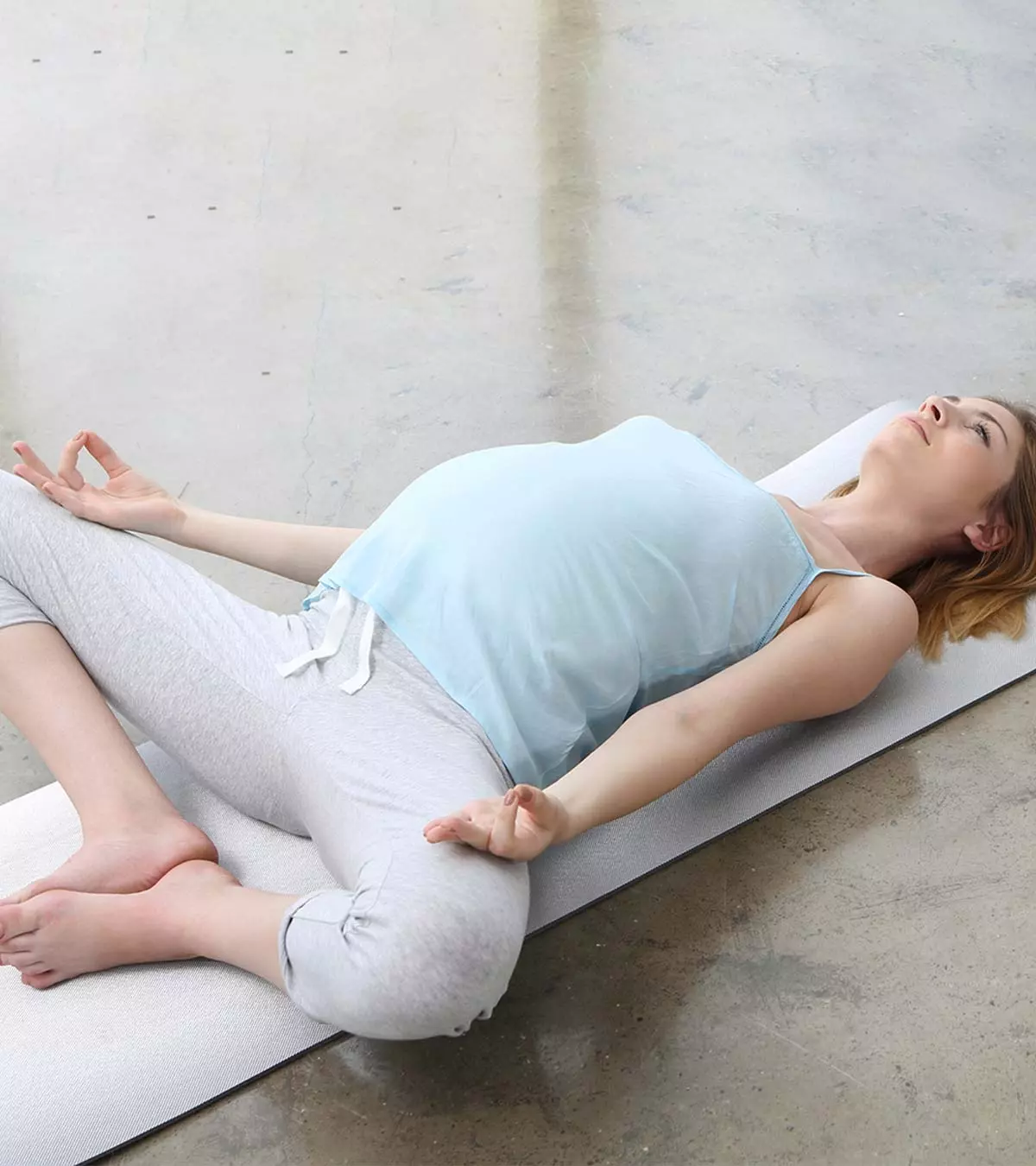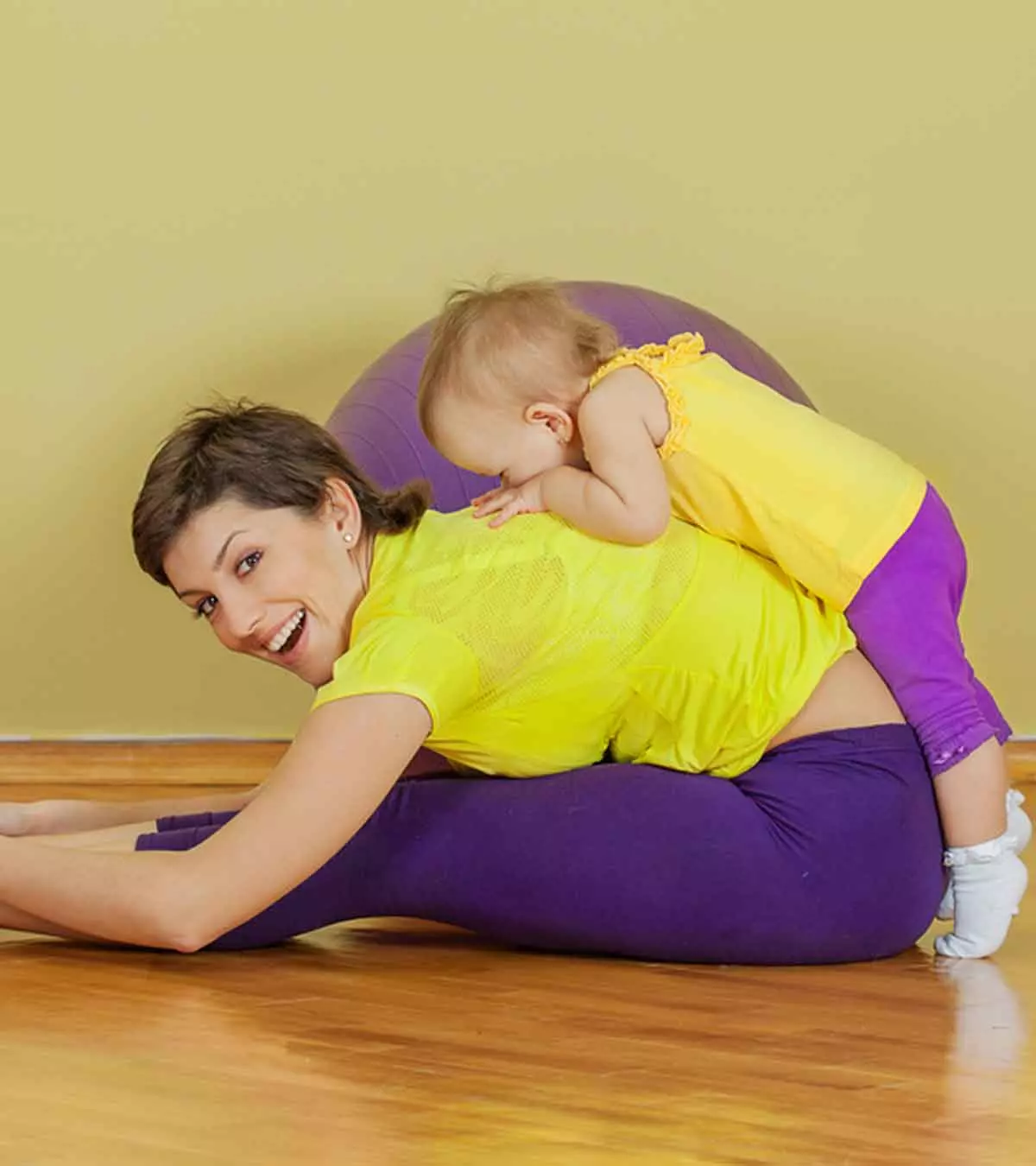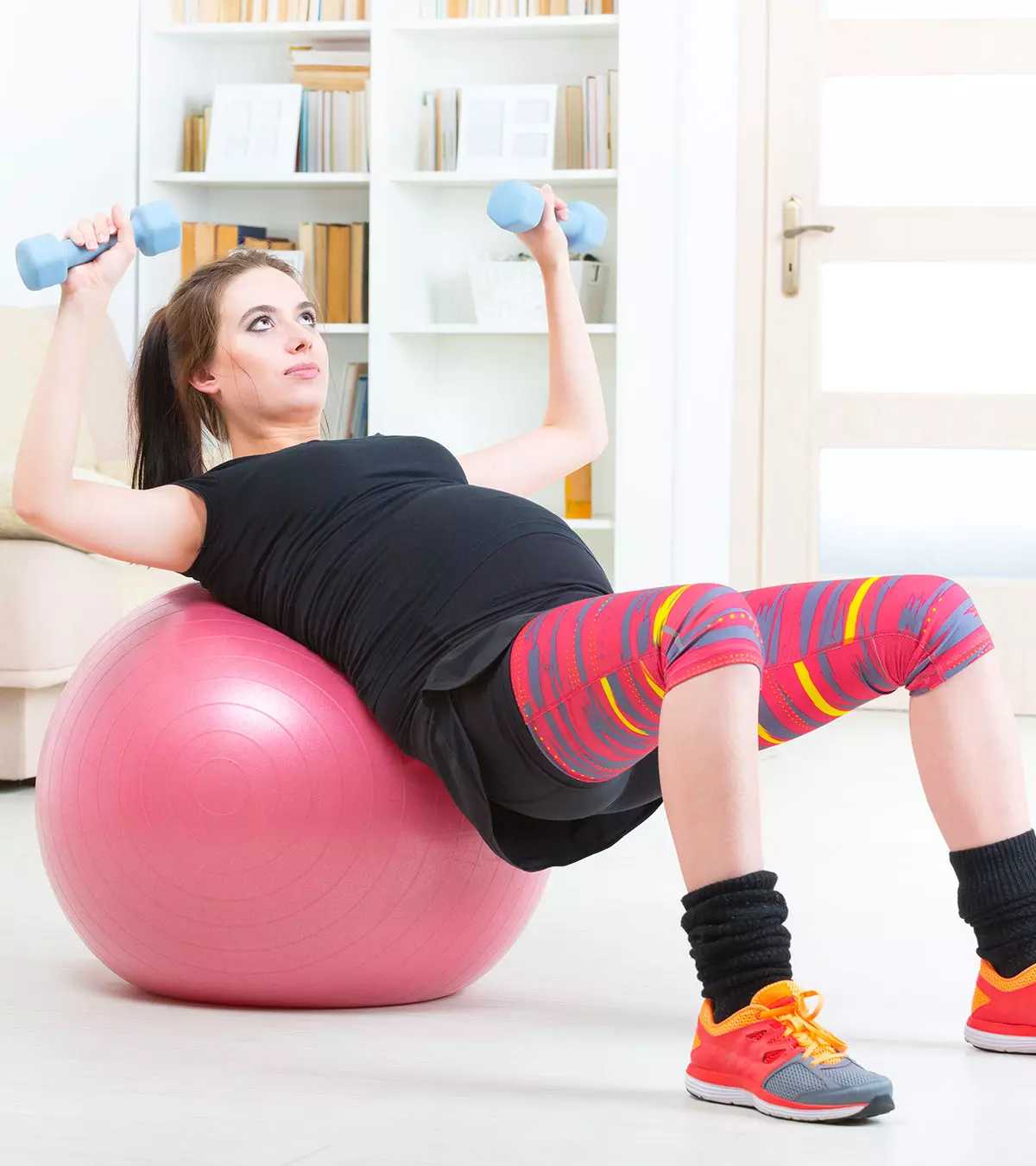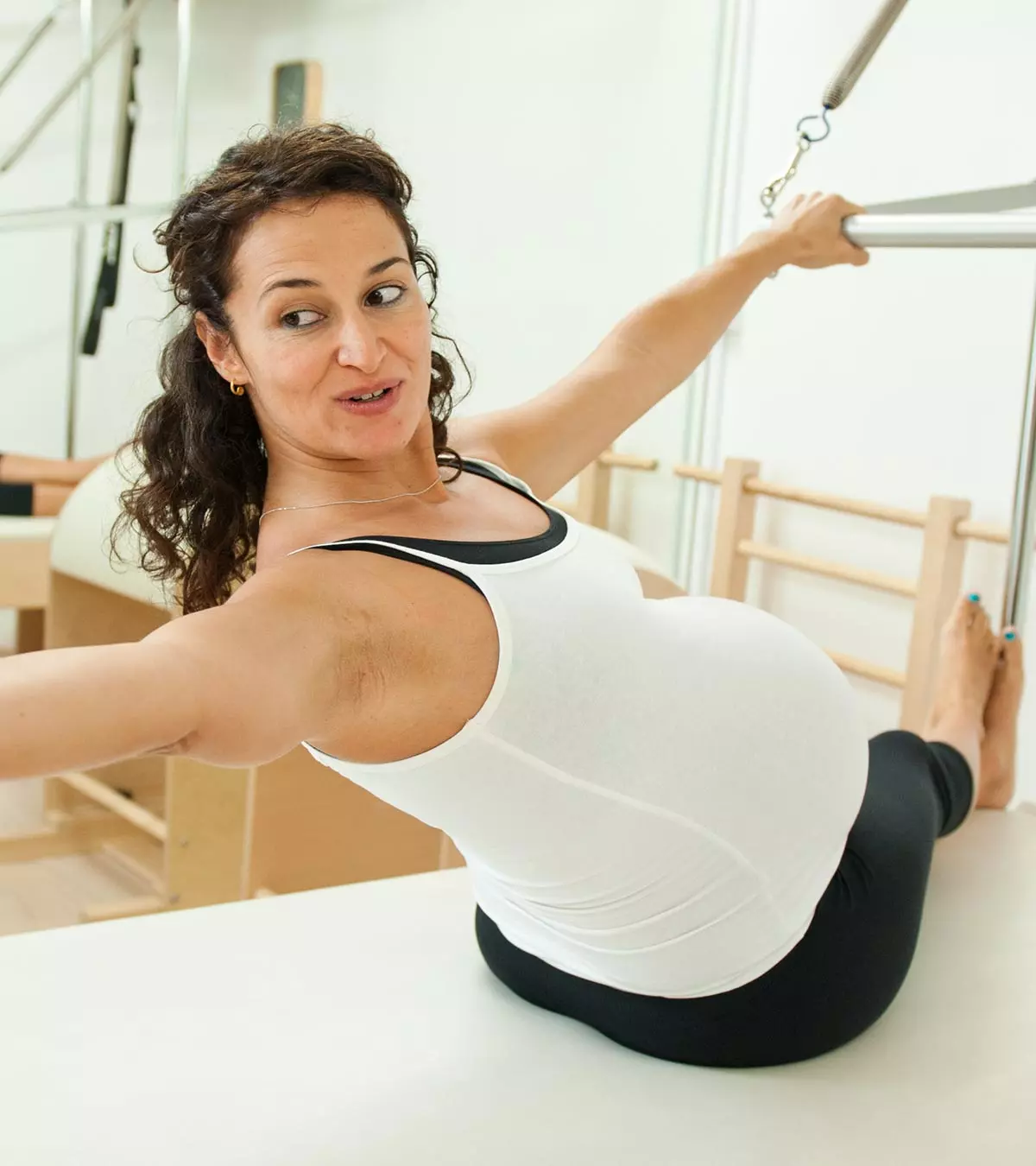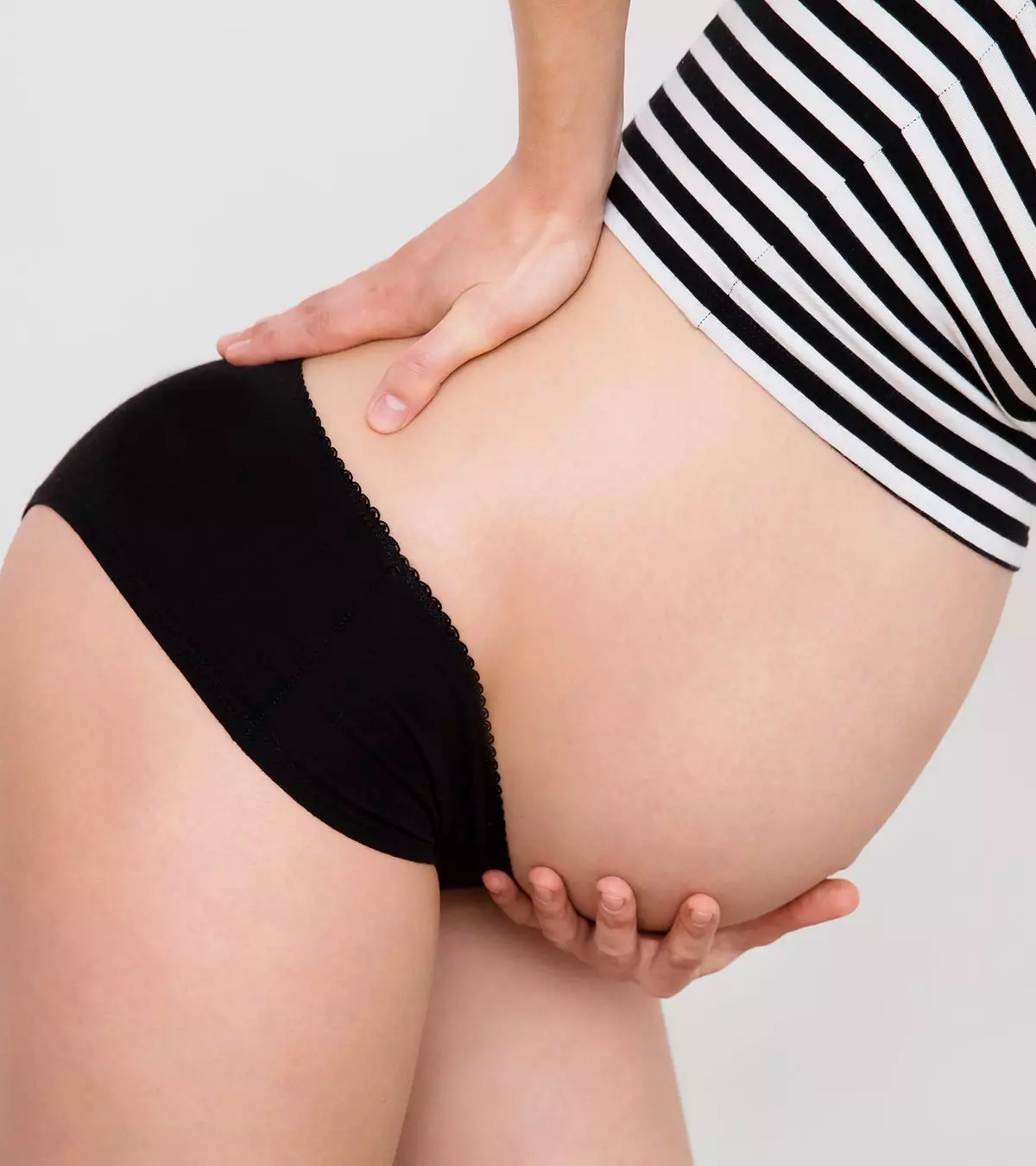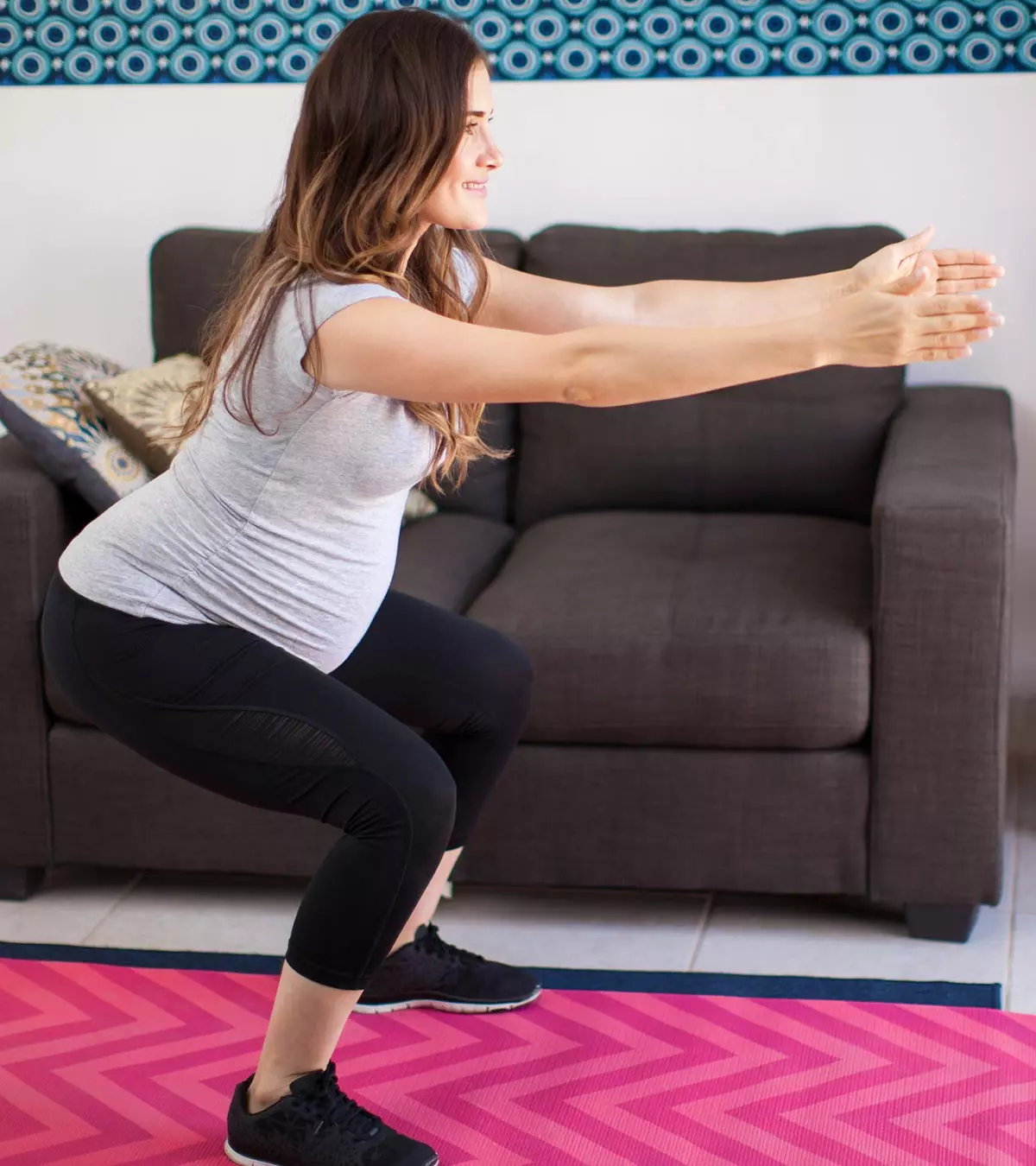
Image: ShutterStock
Performing squats during pregnancy might be beneficial as the simple movement of lowering the hips then standing back strengthens the lower half, pumps the heart rate, and tones the body. But there’s a catch, performing squats in excess may leave you feeling tired and weak. Hence, the benefits are limited to doing it in the required repetitions. Read on to know more about squats, their benefits, guidelines, and when to avoid squats. Also, it is better to consult a doctor before you begin them.

Key Pointers
- Squats can be beneficial for pregnant women under doctor’s guidance.
- They can help reduce discomfort, lower back pain, strengthen pelvic floor muscles, and improve birth posture.
- It’s important to have someone help with props or balance during squats.
- Intensity should be decreased during the second trimester.
- Stop exercising if experiencing pain, tiredness, or discomfort.
Is It Safe To Do Squats During Pregnancy?
Yes, squats are one of the best exercises to keep you healthy and make you feel better during pregnancy, provided you do not overdo them or indulge in a strenuous prenatal exercise.
You can continue with this exercise throughout, for a healthy pregnancy. However, it is advisable to check with your doctor before beginning any pregnancy workout routine. Also, talk to them about any specific concerns or conditions that affect your ability to perform squats safely. They may recommend modifications or alternative exercises based on your health profile.
Squats help build the lower body strength and facilitate smooth movement of the hips, core, and pelvic floor muscles. Squatting also helps open up your pelvis and assist your baby’s descent.
Benefits Of Squatting During Pregnancy
Now you know that these low-impact exercises are good for you and your baby. Let’s see them in detail:
- Strengthen glute muscles: Squat workouts help strengthen your glute muscles. Moreover, it helps maintain the shape of your bottom.
- Alleviate lower back ache: Your back pain, which is common during pregnancy, is relieved as squatting exercises help stretch your lower back areas. The pain is caused due to ligamentiFibrous connective tissue that supports organs, bones, and joints loosening.
- Prevent constipation: A majority of women experience constipation as they near the end of pregnancy. Squats help in the normal functioning of the digestive system and relieve flatulenceiAlso called farting, it is the act of passing gas through the anus (1).
- An excellent birth posture: Squatting positions help you cope with contractions during labor. The exercises facilitate the expansion of the birth canal which aids childbirth preparation by making it an easy descent for your baby. Squatting also helps in relaxation of the perineal musclesiA group of muscles located in the perineum, the area between the genitals and the anus (2).
- Strengthen the leg muscles: Squatting during the third trimester helps improve leg strength. Strong legs help in labor and the final push to give birth.
- Strengthen the pelvic floor muscles: Squatting helps to lower the pressure on pelvic floor muscles, strengthen them and prepare the muscles for birthing (3).
- Enhances circulation: Squats improve blood flow throughout the body and help reduce swelling in the legs and feet.
- Maintain center of gravity of the body: Squatting exercises during pregnancy help in maintaining the center of gravity of your body, which shifts during pregnancy (4).
As your pregnancy matures, there is discomfort in your body. Squatting alleviates the discomforts and helps you maintain your pregnancy fitness.
Cannot wait to do them? Then you need to know how to do various squat exercises.
Squats You Can Perform During Pregnancy
Eira Vanora, a mother and a blogger, reveals the significance of incorporating squats and lunges into her prenatal exercise routine. She conveys, “You can use weights with both exercises but always remember to maintain at 70% – 80% intensity. What I do is that I cut down my regular weight to 50%, so if I was using a 6kg dumbbell before I was pregnant, now I just use 3kg (i).”
Here are a few squatting exercises that you can try during pregnancy. Even though they are safe, check with your doctor before trying the different squat variations.
1. Simple squat
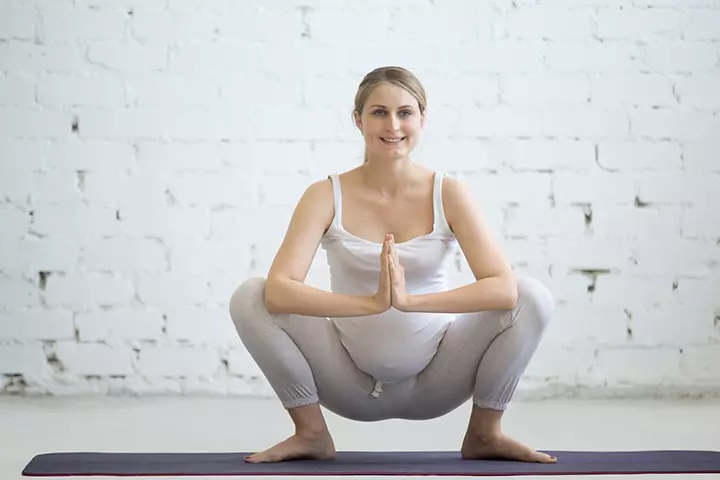
It is one the easiest squats to perform throughout your pregnancy without using any equipment. Simple squats will prevent or reduce the pain and discomfort in your lower back area.
How to do:
- Stand with your feet shoulder-width apart and turn your feet in an outward direction to maintain your balance.
- Bring both your arms in front of you and press your palms together. Slowly bend your legs in a deep squatting position.
- Open out your palms and press your knees with both your hands to make space for your tummy. Slightly bend towards the front, maintaining your balance.
- Hold the position until you feel comfortable.
 Quick tip
Quick tip2. Sumo squats
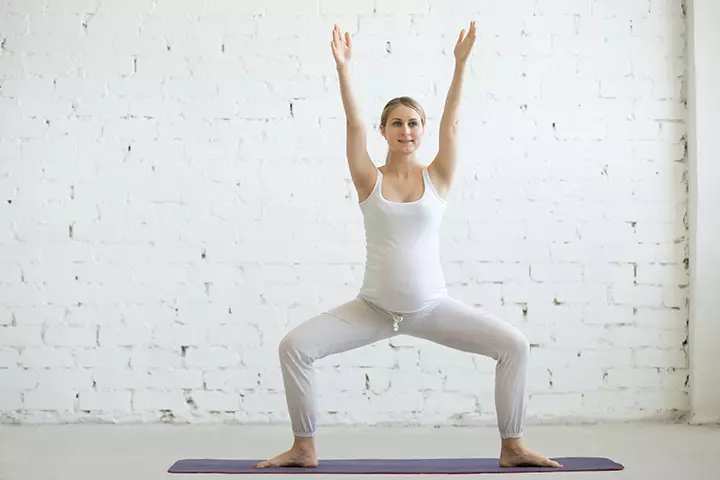
It targets the inner muscles of the thighs and glutes and opens up the hips.
How to do:
- Stand straight and keep your feet wider than shoulder-width apart with your toes pointing outward and knees in line with the toes.
- Lower yourself into the squat position as far as you are comfortable.
- Make sure that your knees do not cave in toward each other.
- Return to your normal position by squeezing your glutes up.
- Perform a set of this exercise with 10 to 15 repetitions.
3. Dumbbell squat

They help with glute strength and leg muscles. It also maintains the shape of your bottom.
How to do:
- Stand straight with feet shoulder-width apart.
- Take dumbbells in hand then stretch your arms towards the front for balance.
- Slowly lower your position into a squat position as far as you are comfortable, keeping your back straight and knees behind or in line with the toes.
- Now, return to the original position by squeezing your glutes muscles up.
- Perform a set of this exercise with 10 to 15 repetitions.
4. Box set-up squat

It helps strengthen your hips, glutes, quads, and lower back.
How to do:
- Put a box firmly on the floor. Place the foot of your first leg on it.
- Extend the knee of the first leg and hip to stand on the box. Then, place the foot of the second leg on the box.
- Step down with the second leg and return to the original position by placing down the foot of the first leg.
- Repeat it with the other legs.
5. Deep squat with pelvic floor contraction

The pelvic floor muscles aid in supporting the uterus, bladder and other organs. As your bump grows during pregnancy, the muscles become weak. It is necessary to keep these muscles active to facilitate smooth delivery.
How to do:
- Stand facing a wall with your feet in a wide sumo squat position.
- Lower your body as much as you can without over-stretching.
- Keep your arms extended in front of you or hold onto the wall for balance.
- Once you attain this squat position, perform a Kegel exercise, wherein you squeeze your pelvic floor in such a way that you are trying to stop the flow of urine.
- Hold your body in this position for ten seconds and return to normal position.
Repeat this exercise for five times.
6. Squats against wall with exercise ball
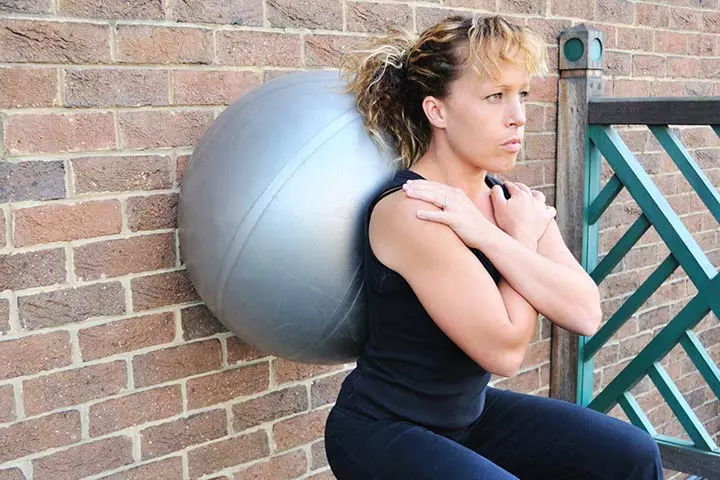
This exercise helps in strengthening the core muscles during the squat movement.
How to do:
- Stand straight with your back erect against a wall.
- Keep an exercise ball between the wall and your lower back.
- Place your feet shoulder-width apart.
- Stretch out your arms in front of your body for balance.
- Lower yourself as far as you are comfortable.
- If you are putting a lot of pressure on your knees, then stretch your feet far enough maintaining a 90-degree angle at the knee.
- Return to the original position.
Perform a set of this exercise with 10 to 15 repetitions.
7. Chair squats
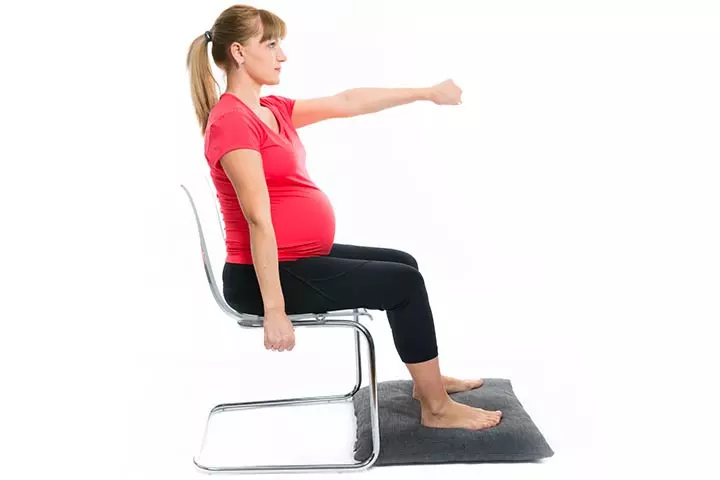
This exercise, also known as half chair squats, is a modified squat and works for women who are not comfortable with regular squats.
How to do:
- Stand erect with feet shoulder-width apart.
- Now, slightly sit back into the chair with your bottom resting on it for one to two seconds.
- Stand back to the original position slowly using your glutes muscles.
- Once you are comfortable with the exercise, you can increase the duration of holding time to 15 seconds and gradually to 60 seconds.
Perform a set of 10 to 15 repetitions.
8. Standing pile squats

Engaging in standing plie squats serves to strengthen your pelvic floor, gearing up your body for the labor journey.
How to do:
- Position yourself with heels close and toes spread, one hand resting on a chair, the other on your hip. Alternatively, you can rest both hands on hips, however, a chair ensures better support to avoid falls.
- Elevate onto your toes, maintaining an upright stance.
- Gradually flex your knees, ensuring good posture.
- Gently bring your heels down to the ground.
- Now, invert the sequence: bend your knees once more. Elevate your heels, ensuring your knees stay bent. Straighten your legs, then lower your heels to conclude the exercise.
- Complete a set of this routine, tallying up 20 repetitions in each direction.
Apart from the above-mentioned squats, a few equipment-based squats can be performed during pregnancy. Before you start with squats, take your doctor’s advice. Based on your health condition, they can advise you on the squats that are safe for you to get the utmost fitness benefits.
How Do Physical Changes During Pregnancy Affect Squats?
You may begin squatting early in pregnancy, but as the weeks pass, your growing tummy and changing body will have an impact on the way you exercise. Therefore, you need to adjust your exercise routine to suit those changes.
Things to remember:
- The hormones produced during pregnancy cause the ligaments of the joints to stretch, which can lead to increased risk of injuries (5).
- An uneven distribution of your body weight shifts the center of gravity. Moreover, if you are using any equipment such as in a weight-bearing exercise, the extra weight puts stress on the joints and muscles in the pelvic area and the lower back leading to loss of balance.
Therefore, you need to follow certain safety precautions when doing squats while pregnant.
Basic Guidelines To Follow While Doing Squats
Here are a few exercise precautions you should remember while squatting in pregnancy:
- You can increase the intensity of exercises in the first trimester as long as you are comfortable doing it. You may increase the number of repetitions.
- During the second trimester, lower the intensity of squatting because your tummy might just be growing. Also, stop doing any pregnancy exercises, which are difficult to perform.
- Ask somebody to be around, as you might need help with the props or in maintaining your balance.
- Drink a lot of water to keep yourself hydrated. Keep a water bottle with you and take sips in between the workouts.
- Wear loose fitting, comfortable cotton clothes that allow air to flow and prevent excessive sweating while squatting.
- Wear a good quality maternity bra that gives extra support to your breasts as you exercise. Do not wear under-wired bras as they may cause discomfort or pain while exercising.
- Your shoes should protect you against any injury when doing the squats. The shoe that you wear should have an anti-skid sole and fit you properly without hurting the toes. Tie the shoelaces properly before beginning any exercise.
- Perform the squats on a flat surface to avoid any risk of slipping and falling.
- Avoid doing squats right after the meal. Maintain a gap of one hour or so between your meals and the exercise regime.
- Avoid performing squats on an empty stomach.
- Before starting your squats, engage your pelvic floor muscles to provide additional support to your body during exercise.
- Avoid overdoing the squat exercises. If you feel exhausted, then stop doing it or slow down your activity.
 Point to consider
Point to considerIn spite of the safety precautions, squats can prove to be bad in certain cases.
When Should You Not Squat?
Your pregnancy health is of prime importance, hence you should know the times when you must avoid squats:
1. When the baby is not in an optimal position after 30 weeks
If your baby is not in a head-down position, avoid performing squats. And if you experience dizziness or shortness of breath while squatting, stop immediately and consult your healthcare provider. Squatting might push the baby’s bottom further down to the pelvis into an awkward position. If your baby turns into an optimal position (i.e., head-down), then you can start squatting again.
2. Pain
While doing squats, if you experience any pain then stop exercising. Discuss your squatting technique with your doctor before resuming your exercise.
3. Medical reasons
If you have any medical complications such as low-lying placenta, the risk of preterm labor, placenta previaiA pregnancy complication where the placenta obstructs the cervix, causing difficulties in vaginal delivery , short or funneling cervix, or multiple pregnancies then you would not want to induce early labor by squatting.
 Quick tip
Quick tipCan Squats Induce Labor?
Yes. They can. Squatting helps open the pelvic area and strengthen the muscles around it. The pelvic opening provides more space for your baby to descend the uterus, which causes the cervix dilate, thereby inducing labor.
When you do squats to induce labor, it creates more room for the baby to move down into the birth canal.
A study has found that women who deliver in a squatting position (6):
- Have fewer chances of instruments, such as forceps, being used for the delivery.
- Can avoid second and third degree perineal tears.
- Have less need for an extension of episiotomiesiSurgical cuts made between the anus and the vagina (perineum) for smooth delivery of the baby .
Frequently Asked Questions
1. Is it safe to do squats in my third trimester?
You can perform squats in all trimesters of pregnancy unless your doctor has advised you not to or you have certain pregnancy-related complications (7).
2. What muscles are used when squatting?
Over 200 muscles are at work while squatting. Some of them are (8):
- Soleus at posterior of the leg
- Quadriceps femoris (vastus lateralis, vastus medialis, vastus intermedius, and rectus femoris) about the knees
- Gluteus maximus (GM) and the hamstrings at the hips
- Muscles supporting the vertebral column such as transversus abdominis, erector spinae, quadratus lumborum, and deep posterior spinal group
From the first trimester to the delivery, squats during pregnancy can help you at every stage. Squats can also help you go through smooth labor. However, you should begin with light and simple exercises. You may gradually increase the intensity to a certain level once you think your body is strong enough and has the required stamina. Also, remember you can do them only if you are feeling comfortable. Therefore, the best thing is to consult your doctor before beginning your squat exercise regimen.
3. What are the best times during pregnancy to do squats?
Pregnant women can do squats in all three trimesters of pregnancy. However, if you have not started it yet, the second trimester is generally considered the best time to begin active exercises like squats as your body has adapted to the pregnancy changes, and you are likely to have more energy (11). However, speak to your doctor before you start doing squats. Also, listen to your body and modify squatting techniques whenever needed to avert excessive strain and discomfort.
4. Can squats help with postpartum recovery?
Squats are compound exercises that target the lower body muscles, including the glutes and hamstrings. Additionally, they may help strengthen the pelvic floor and core muscles, which may benefit postpartum recovery and healing after childbirth. However, it is vital to approach postpartum exercise cautiously and consult your healthcare provider before starting any new exercise regimen (12).
Infographic: Rules To Follow While Doing Squats During Pregnancy
Squats are a great exercise during pregnancy to improve balance and prepare your body for labor and childbirth. However, as your pregnancy progresses, you may need to modify your squat technique to accommodate your growing belly. Check out the infographic below for basic instructions for doing squats during pregnancy.
Some thing wrong with infographic shortcode. please verify shortcode syntax
Illustration: Squats During Pregnancy: 8 Exercises To Do And Guidelines To Take

Image: Stable Diffusion/MomJunction Design Team
Learn how to safely squat during pregnancy with this helpful video! Get tips on proper form and technique to ensure a safe and comfortable workout.
Personal Experience: Source
MomJunction articles include first-hand experiences to provide you with better insights through real-life narratives. Here are the sources of personal accounts referenced in this article.
i. Squats and Lunges while Pregnant – Yes or No?https://godlovelifemusic.wordpress.com/2015/09/13/squats-and-lunges-while-pregnant-yes-or-no/
References
- Roger L Hammer; 2000; Exercise During the Childbearing Year; The Journal of Perinatal Education
https://pmc.ncbi.nlm.nih.gov/articles/PMC1595006/ - S.A. Fazlani; (2004); Protocols for Exercise during Pregnancy.
https://athlon-esportes.com/wp-content/uploads/2014/01/Protocols-for-exercise-during-pregnancy.pdf - Pelvic floor exercises.
https://www.pregnancybirthbaby.org.au/pelvic-floor-exercises - Preventing a Fall During Pregnancy: Strength and Balance Exercises.
https://www.dignityhealth.org/articles/preventing-a-fall-during-pregnancy-strength-and-balance-exercises - Exercise During Pregnancy
https://www.acog.org/womens-health/faqs/exercise-during-pregnancy?utm_source=redirect&utm_medium=web&utm_campaign=otn - Ayesha Nasir et al., (2007); Child birth in squatting position
https://pubmed.ncbi.nlm.nih.gov/17319414/ - Squats for pregnant women: prenatal fitness tips
https://blog.nasm.org/squats-for-pregnant-women - BRAD J. SCHOENFELD (2010); SQUATTING KINEMATICS AND KINETICS AND THEIR APPLICATION TO EXERCISE PERFORMANCE
https://www.dentonisd.org/cms/lib/tx21000245/centricity/Domain/700/Everything_you_need_to_know_about_Squatting.pdf - Safety and Benefits of Exercise.
https://www.acog.org/womens-health/faqs/exercise-during-pregnancy - Not All Squats Are Created Equal in Labor & Birth.
https://www.lamaze.org/Giving-Birth-with-Confidence/GBWC-Post/not-all-squats-are-created-equal-in-labor-birth - Exercise During Pregnancy
https://www.rush.edu/news/exercise-during-pregnancy - Pelvic Floor Exercises
https://nafc.org/step-4-start-implementing-exercises/
Community Experiences
Join the conversation and become a part of our nurturing community! Share your stories, experiences, and insights to connect with fellow parents.
Read full bio of Dr. Burcu Saygan Karamürsel
Read full bio of sanjana lagudu
Read full bio of Rebecca Malachi
Read full bio of Reshmi Das









